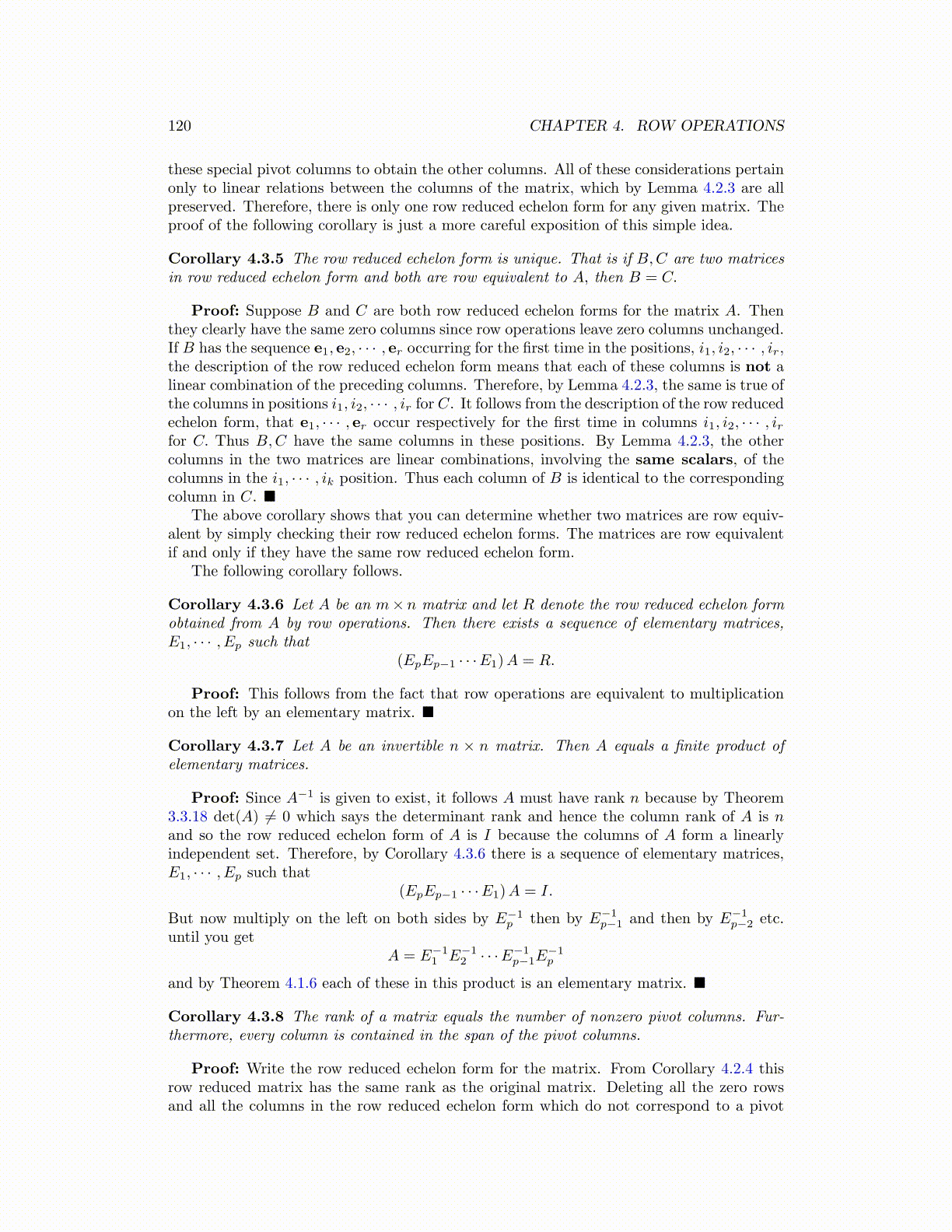
120 CHAPTER 4. ROW OPERATIONS
these special pivot columns to obtain the other columns. All of these considerations pertainonly to linear relations between the columns of the matrix, which by Lemma 4.2.3 are allpreserved. Therefore, there is only one row reduced echelon form for any given matrix. Theproof of the following corollary is just a more careful exposition of this simple idea.
Corollary 4.3.5 The row reduced echelon form is unique. That is if B,C are two matricesin row reduced echelon form and both are row equivalent to A, then B = C.
Proof: Suppose B and C are both row reduced echelon forms for the matrix A. Thenthey clearly have the same zero columns since row operations leave zero columns unchanged.If B has the sequence e1, e2, · · · , er occurring for the first time in the positions, i1, i2, · · · , ir,the description of the row reduced echelon form means that each of these columns is not alinear combination of the preceding columns. Therefore, by Lemma 4.2.3, the same is true ofthe columns in positions i1, i2, · · · , ir for C. It follows from the description of the row reducedechelon form, that e1, · · · , er occur respectively for the first time in columns i1, i2, · · · , irfor C. Thus B,C have the same columns in these positions. By Lemma 4.2.3, the othercolumns in the two matrices are linear combinations, involving the same scalars, of thecolumns in the i1, · · · , ik position. Thus each column of B is identical to the correspondingcolumn in C. ■
The above corollary shows that you can determine whether two matrices are row equiv-alent by simply checking their row reduced echelon forms. The matrices are row equivalentif and only if they have the same row reduced echelon form.
The following corollary follows.
Corollary 4.3.6 Let A be an m× n matrix and let R denote the row reduced echelon formobtained from A by row operations. Then there exists a sequence of elementary matrices,E1, · · · , Ep such that
(EpEp−1 · · ·E1)A = R.
Proof: This follows from the fact that row operations are equivalent to multiplicationon the left by an elementary matrix. ■
Corollary 4.3.7 Let A be an invertible n × n matrix. Then A equals a finite product ofelementary matrices.
Proof: Since A−1 is given to exist, it follows A must have rank n because by Theorem3.3.18 det(A) ̸= 0 which says the determinant rank and hence the column rank of A is nand so the row reduced echelon form of A is I because the columns of A form a linearlyindependent set. Therefore, by Corollary 4.3.6 there is a sequence of elementary matrices,E1, · · · , Ep such that
(EpEp−1 · · ·E1)A = I.
But now multiply on the left on both sides by E−1p then by E−1
p−1 and then by E−1p−2 etc.
until you getA = E−1
1 E−12 · · ·E−1
p−1E−1p
and by Theorem 4.1.6 each of these in this product is an elementary matrix. ■
Corollary 4.3.8 The rank of a matrix equals the number of nonzero pivot columns. Fur-thermore, every column is contained in the span of the pivot columns.
Proof: Write the row reduced echelon form for the matrix. From Corollary 4.2.4 thisrow reduced matrix has the same rank as the original matrix. Deleting all the zero rowsand all the columns in the row reduced echelon form which do not correspond to a pivot